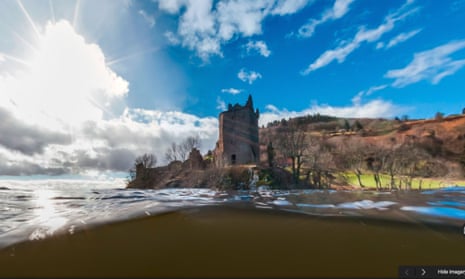Google has just uploaded some Street View images of Loch Ness in Scotland, above and below the surface. As far as I can tell, there is no sign of a monster. But they did remind me of a historical footnote from the 1970s when conservation pioneer Sir Peter Scott became involved in efforts to scour the loch for a Nessie-like creature.
More than 50 years ago, in 1961, Scott met up with several like-minded colleagues at the House of Commons in London and set up the Loch Ness Investigation Bureau. Over the next 15 years or so, he took part in a quasi-serious effort to explore Loch Ness for signs of monster.
In 1971, the Bureau deployed sonar transducers, time-lapse cameras and strobe flash lighting in Urquhart Bay (which happens to be the spot in which Google has also filmed) in the hope of photographing the monster underwater for the first time. In 1972, two frames showed signs of a spearheaded object. When enhanced by the Jet Propulsion Laboratory at the California Institute of Technology in Pasedena, they looked a little like a flipper (see here). According to Nessie enthusiast Robert Rines of the Massachusetts Institute of Technology, these two images “suggest quite strongly the presence of two animals.”
Three years later, in June 1975, a single camera captured what became known as the “Gargoyle shot” that appeared to show a large head with horny protrusions (see here) and another photo of what seemed to be the entire creature (here). According to Peter Scott’s biographer Elspeth Huxley, it was this second image that convinced Scott that the Loch Ness monster was real. “My own guess is that they might look rather like plesiosaurs,” he wrote.
Later that year, Scott and Rines excitedly named the beast in the journal Nature: Nessiteras rhombopteryx. Their reason for doing so was one of conservation. “A name for a species whose existence is still a matter of controversy among many scientists is preferable to none if its protection is to be assured,” they wrote.
“This was a rash thing to do,” writes Huxley, “and was to tarnish Peter’s reputation in some scientific circles.”
Rather appropriately, it turns out that there is an anagram of Nessisteras rhombopteryx, pointed out in the Daily Telegraph a few days later: “Monster hoax by Sir Peter S.”
Peter Scott: Painter and Naturalist by Elspeth Huxley (Faber and Faber, 1993)

Comments (…)
Sign in or create your Guardian account to join the discussion